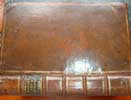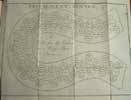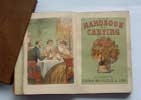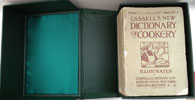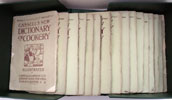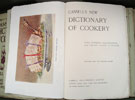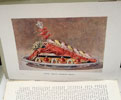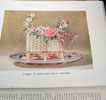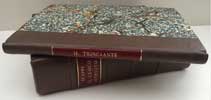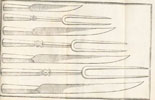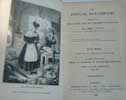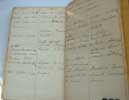The Complete Practical COOK
Or, A NEW SYSTEM Of the Whole Art and Mystery of COOKERY. Being a Select Collection od Above Five Hundred RECIPES for Dressing, after the most Curious and Elegant Manner (as well FOREIGN as ENGLISH) all Kinds of Flesh, Fish, fowl, &c. [a single thin line] FITTED FOR ALL OCASIONS: But more especially for the most Grand and Sumptuous Entertainments. [a single thin line] [a single thin line] Adorned with Sixty curious Copper Plates; Exhibiting the full Seasons of the Year, and Tables proper for Every Month; As also Variety of large Ovals and Rounds, and Ambogues and Square Tables for Coronation-Feasts, Instalments, &c. [a single thin line] The Whole intirely [sic] New; And none of the RECIPES ever published in any Treatise of this Kind. . [a single thin line] Approved by divers of the Prime Nobility; And by several Masters of the Art and Mystery of Cookery. [a single thin line] By CHARLES CARTER, Lately cook to his Grace the Duke of Argyll, the Earl of Pontefract, the Lord Cornwallis, &c. . [a single thin line] LONDON: Printed for W. Meadows, in Cornhill; C. Rivington, in St. Paul's Church-Yard; and R. Hett, in the Poultry. M.DCC.XXX.
FIRST AND SOLE EDITION. 4to. 255 x 202 mm.2 feps. Title page, printed in red and black. [1] Dedication page. [1] 10 pages To the Reader. [1] (1)2-208. 209 - 212 Terms of Art. (1)214 - 224 The Contents. 60 engraved plates, 3 folding. Spectacular fold-out contains dishes for King George II Coronation dinner. Some foxing to edges, but otherwise nice and clean. The edges of the text block nicely speckled. Full tan calf with spine and boards tooled in gilt. Spine with raised bands and red morocco label in gilt. Rebound by Chris Lewis of Bath, formerly a binder at Bayntun-Riviere. From the estate of Dan Samuel, 4th Viscount Samuel (1925-2014), grandson of Herbert Louis Samuel, 1st Viscount Samuel, High Commissioner of Palestine (1920-1925). A very good copy.
- Sam Bilton wrote online, the following article about Charles Carter and his book; The Complete Practical Cook. Her acute observations are worth re-printing here in their entirety: " Long before chefs began coveting stars, their reputations were built on the social standing of their patron. The bigger the ‘nob’ you worked for, the more prestige your position as a chef held in the 18th century. Charles Carter’s patrons included the Duke of Argyll, General Wood and several lords. He had the advantage of having worked in several European countries where he had been exposed to a wider variety of flavours (like garlic) than many of his English counterparts. He was very proud of his achievements and doesn’t shy away from telling the reader so in the introduction. Despite his lack of modesty, a lot of what Carter says still holds true today. He believes cookery is an art and that good cooks should be rewarded for their skill. He is highly critical of unscrupulous cooks who pass off the work of others as their own. He even starts the book by extolling the virtues of a good stock, a maxim which is as true now as it was in the 18th century. The recipes are very much of their time, with many meat-based dishes beloved by his wealthy benefactors. Nose to tail eating was definitely the order of the day. The recipe for 'Olio Podred'a (a type of Spanish stew) contains 11 breeds of bird including pheasants, ducks and larks plus beef, pork, veal and mutton, not to mention hogs ears, trotters, sausages and ham. The dish is served with a ragout of pallets, sweetbreads, lamb stones, cockscombs and a hefty dose of truffles. You get the meat sweats just by reading the recipe. A few recipes, like 'To Pot Otter' ', Badger or Young Bea'r, are decidedly odd and are likely to offend some 21st century sensibilities. However, others like 'Buttered Crab' ' Eggs à la Switz' (a spiced-up version of eggs florentine), 'Pike Babacu’d' or 'Beef la Tremblour' (slow cooked rump or sirloin, till it is so tender that it will tremble or shake like a quaking pudding) sound reassuringly familiar once you get past the archaic language. Some like 'Tamarind Tort' or 'Caraway Cakes' are crying out to be rediscovered by a modern audience. Unlike modern cookery books there is no strict division between savoury and sweet dishes reflecting the way meals were served 'à la francaise'. Carter even provides a large number of diagrams at the back of the book with suggestions for different dinners according to the season or occasion. (One of the folding plates measures a whopping 500mm long. See image #6 below) Clearly for the 21st century cook, this is far from a practical book. The recipes are designed to cater for large households so inevitably require scaling down. Some of the ingredients he uses, like 'eringo roots' (candied sea holly roots) or 'ambergris' (whale vomit) are difficult to come by or are best avoided. Carter claims this book will make cooks more inventive and a certain degree of ingenuity is required to make these recipes work today. If you have any interest in England’s culinary heritage it’s worth persevering with The Complete Practical Cook if for no other reason than to prevent it from being forgotten". [From the 'Cookbook Review' blog online]. Oxford p.61. Cagle p.592. Bitting p.77. Axford p.75. MacLean p.23.






click on image to enlarge

Antiquarian category
ref number:
10981 